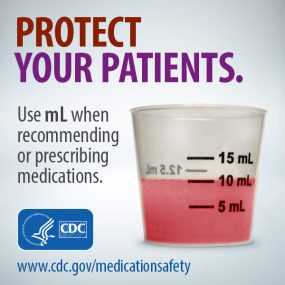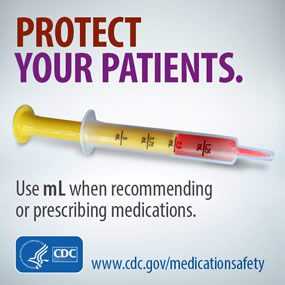Additional Resources
Graphics
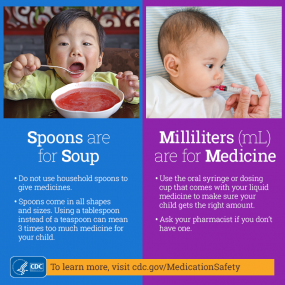
Spoons are for Soup / Milliliters (mL) are for Medicine The average tablespoon holds three times as much medicine as a teaspoon. Don’t use household spoons to give liquid medicines. Instead, use the dosing device that comes with your child’s medicine (oral syringe or dosing cup) to make sure that he or she gets the right amount. Ask your pharmacist if you don’t have one.
Videos
Emergency Visits for Adverse Drug Events (2:21)
The CDC’s Medication Safety Program wants you to know more about the leading causes of emergency department visits due to adverse drug events.
Coffee with America: Protect Kids from the Dangers in our Medicine Cabinets (5:05)
This video interview educates parents about the “Up and Away” campaign’s efforts to protect kids from medication overdoses. (Coffee with America, 2016)

CDC Expert Commentary: Hypoglycemia in Insulin-Treated Patients (3:26)
This video commentary discusses low blood sugar (hypoglycemia) and medication errors among patients with diabetes who are treated with insulin. (CDC Expert Commentary, Medscape, 2014)

CDC Medscape Commentary: Antivirals, Not Antibiotics, for Influenza (5:16)
This video commentary highlights the importance of appropriate prescribing of antibiotics—and explains why antivirals should be used instead of antibiotics for treating the flu. (CDC Expert Commentary, Medscape, 2014)

Flow Restrictors May Help Prevent Medication Poisonings in Young Children (2:23)
This video commentary describes the results of a CDC and Georgia Poison Center study that evaluated how effective flow restrictors can be for preventing young children from getting into liquid medicines when adults are not looking. (CDC, 2013)

CDC Expert Commentary: Medication Use in Pregnancy (4:50)
This video commentary is focused on medication use during pregnancy. (CDC Expert Commentary, Medscape, 2011)

CDC Expert Commentary: What to Tell Your Patients About Medication Safety (5:03)
This video commentary provides tips for healthcare providers to share with parents about using medicines safely. (CDC Expert Commentary, Medscape, 2010)

How to Store Medicines Safely Up and Away (0:30)
This video from the “Up and Away and Out of Sight” campaign provides simple tips to protect kids from medication overdoses by storing and using medicines safely. (Know Your OTCs, 2016)
Podcasts
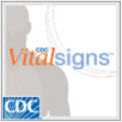
Vital Signs-Preventing Prescription Drug Overdose (1:15)
This podcast is based on the July 2014 CDC Vital Signs report. Every day, 46 people in the U.S. die from an overdose of prescription opioid painkillers. Learn what can be done to make prescribing safer and help prevent overdoses. (Podcasts at CDC, 2014)

Signos Vitales de los CDC Prevención de las sobredosis de medicamentos recetados (1:37)
Este podcast se basa en la edición de julio del informe Signos Vitales de los CDC. Todos los días, 46 personas mueren en los EE. UU. de una sobredosis de analgésicos opioides recetados. Infórmese sobre lo que se puede hacer para que la prescripción de analgésicos sea segura y para ayudar a prevenir las sobredosis.
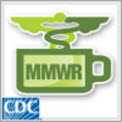
This podcast discusses the dangers of drug poisonings, one of the leading reasons for emergency department visits for injuries to children under five years of age. (Podcasts at CDC, 2012)

Good Medicine Can Be Bad for Baby (5:21)
In this podcast Dr. Cheryl Broussard discusses the potential link between birth defects and women taking medications during pregnancy. (Podcasts at CDC, 2011)
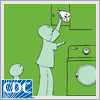
Protect the Ones You Love from Poisoning (2:34)
This podcast, developed as part of the Protect the Ones You Love initiative, discusses steps parents can take to help protect their children from poisoning, one of the leading causes of child injury.
Publications
Related Links Outside CDC
General Medication Safety Other Government Agencies
- Information for Consumers (Drugs), Food and Drug Administration (FDA)
- Buying And Using Medications Safely, Food and Drug Administration (FDA)
- Getting a Prescription, Agency for Healthcare Research and Quality (AHRQ)
- Medical Errors And Patient Safety, Agency for Healthcare Research and Quality (AHRQ)
- Drug Safety, National Institutes of Health (NIH)
- Taking Medicines Safely, National Institutes of Health (NIH)
- Medicines: safety of medicines – adverse drug reactions, World Health Organization (WHO)
Professional Organizations
- Fact Sheet: What You Can Do to Avoid Medication Errors, Institute of Medicine (IOM)
- For Medicine Users, National Council on Patient Information and Education (NCPIE)
- Be MedWise, National Council on Patient Information and Education (NCPIE)
- OTCsafety.org, Consumer Healthcare Products Association (CHPA)
- Safe Medication, American Society of Health-System Pharmacists (ASHP)
- What You Should Know About…Safe Medication, American Society of Health-System Pharmacists (ASHP)
- ConsumerMedSafety.org, Institute for Medication Safety Practices (ISMP)
- Consumer Information for Safe Mediation Use, National Coordinating Council for Medication Error Reporting and Prevention (NCC MERP)
Medication Safety for Children
- Tips for Parents, Food and Drug Administration (FDA)
- Using Over-the-Counter Cough and Cold Products in Children, Food and Drug Administration (FDA)
- Medicines in My Home, Food and Drug Administration (FDA)
Medication Safety for Adults and Older Adults
- Medication Use Safety Training for Senior, National Council on Patient Information and Education (NCPIE)
- What You Can Do to Avoid Medication Errors, AARP
- For Safe Use of Oral Anticoagulants, SOS Rx
- Page last reviewed: August 16, 2017
- Page last updated: August 23, 2017
- Content source:


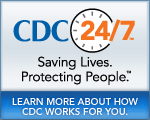
 ShareCompartir
ShareCompartir
